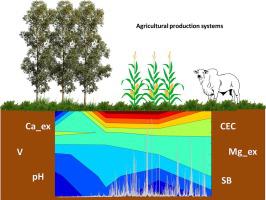Our official English website, www.x-mol.net, welcomes your feedback! (Note: you will need to create a separate account there.)
Laser-induced breakdown spectroscopy (LIBS) as an analytical tool in precision agriculture: Evaluation of spatial variability of soil fertility in integrated agricultural production systems
Catena ( IF 6.2 ) Pub Date : 2024-02-22 , DOI: 10.1016/j.catena.2024.107914 Diego V. Babos , Amanda M. Tadini , Carla P. De Morais , Bianca B. Barreto , Mayara A.R. Carvalho , Alberto C.C. Bernardi , Patricia P.A. Oliveira , José R.M. Pezzopane , Débora M.B.P. Milori , Ladislau Martin-Neto
Catena ( IF 6.2 ) Pub Date : 2024-02-22 , DOI: 10.1016/j.catena.2024.107914 Diego V. Babos , Amanda M. Tadini , Carla P. De Morais , Bianca B. Barreto , Mayara A.R. Carvalho , Alberto C.C. Bernardi , Patricia P.A. Oliveira , José R.M. Pezzopane , Débora M.B.P. Milori , Ladislau Martin-Neto

|
The rapid determination of soil fertility assists in improving agricultural production and reducing environmental impacts. With a new concept of precision agriculture and digital agriculture, new demands have been generated using sensors, methods, and protocols to improve analysis time and agricultural production. In this context, multivariate calibration models (multiple linear regression) were calculated for the indirect prediction of eight parameters of soil fertility, pH (HO and CaCl extractors), cation exchange capacity, sum of bases, base saturation, Ca-exchangeable, Mg-exchangeable, and labile P, using laser-induced breakdown spectroscopy (LIBS), and also, for some parameters laser-induced fluorescence spectroscopy. Soil samples from a native forest (NF) and different agricultural production systems, such as integrated crop-livestock-forest system (CLFS), integrated livestock-forest system (LFS), integrated crop-livestock system (CLS), extensive (EXT), and intensive (INT) pastures, were collected from 0 to 40 cm depth (195 samples). Calibration models with good performance (0.62 ≤ R values ≤ 0.87, and 1.61 ≤ residual prediction deviation values ≤ 2.86) and adequate root mean squared error of prediction (RMSEP) values were obtained for the seven fertility parameters (0.74 ≤ r values ≤ 0.97, for the validation set), except for labile P (r = 0.44 and RPD = 1.35). Through principal component analysis (PCA) it was verified the formation of two clusters, referring to samples of more fertile soils of the production systems (CLFS and LFS) and NF that present the tree variable, and the other group referring to samples of soils of low fertility (EXT, INT, and CLS). To evaluate and exemplify the use of LIBS for precision and digital agriculture, in-depth soil chemical attributes and spatial variability, maps were obtained for an analyzed area of the integrated CLFS. The LIBS technique can determine and assist in evaluating the variability of soil fertility attributes with reliability, agility (without the need for extraction procedures since the soil is thoroughly analyzed in the form of pellets), and accuracy.
中文翻译:

激光诱导击穿光谱(LIBS)作为精准农业的分析工具:综合农业生产系统中土壤肥力空间变异性的评估
快速测定土壤肥力有助于提高农业生产并减少环境影响。随着精准农业和数字农业的新概念的出现,产生了使用传感器、方法和协议来缩短分析时间和提高农业产量的新需求。在这种情况下,计算了多元校准模型(多元线性回归),用于间接预测土壤肥力、pH(H2O和CaCl2提取器)、阳离子交换容量、碱基总和、碱基饱和度、Ca交换性、Mg- 等八个参数。可交换且不稳定的 P,使用激光诱导击穿光谱 (LIBS),并且对于某些参数也使用激光诱导荧光光谱。来自原生林(NF)和不同农业生产系统的土壤样本,例如农牧林综合系统(CLFS)、畜牧林综合系统(LFS)、农牧综合系统(CLS)、粗放型(EXT)和集约化 (INT) 牧场,从 0 到 40 厘米深度采集(195 个样本)。对于七个生育参数(0.74 ≤ r 值 ≤ 0.97、对于验证集),但不稳定的 P(r = 0.44 和 RPD = 1.35)除外。通过主成分分析(PCA),验证了两个簇的形成,参考生产系统(CLFS和LFS)和NF的更肥沃的土壤样本,呈现树变量,另一组参考生产系统(CLFS和LFS)的土壤样本低生育率(EXT、INT 和 CLS)。为了评估和举例说明 LIBS 在精准和数字农业、深入土壤化学属性和空间变异方面的应用,获得了综合 CLFS 分析区域的地图。 LIBS 技术可以可靠、灵活(无需提取程序,因为土壤以颗粒形式进行彻底分析)和准确性来确定和协助评估土壤肥力属性的变异性。
更新日期:2024-02-22
中文翻译:

激光诱导击穿光谱(LIBS)作为精准农业的分析工具:综合农业生产系统中土壤肥力空间变异性的评估
快速测定土壤肥力有助于提高农业生产并减少环境影响。随着精准农业和数字农业的新概念的出现,产生了使用传感器、方法和协议来缩短分析时间和提高农业产量的新需求。在这种情况下,计算了多元校准模型(多元线性回归),用于间接预测土壤肥力、pH(H2O和CaCl2提取器)、阳离子交换容量、碱基总和、碱基饱和度、Ca交换性、Mg- 等八个参数。可交换且不稳定的 P,使用激光诱导击穿光谱 (LIBS),并且对于某些参数也使用激光诱导荧光光谱。来自原生林(NF)和不同农业生产系统的土壤样本,例如农牧林综合系统(CLFS)、畜牧林综合系统(LFS)、农牧综合系统(CLS)、粗放型(EXT)和集约化 (INT) 牧场,从 0 到 40 厘米深度采集(195 个样本)。对于七个生育参数(0.74 ≤ r 值 ≤ 0.97、对于验证集),但不稳定的 P(r = 0.44 和 RPD = 1.35)除外。通过主成分分析(PCA),验证了两个簇的形成,参考生产系统(CLFS和LFS)和NF的更肥沃的土壤样本,呈现树变量,另一组参考生产系统(CLFS和LFS)的土壤样本低生育率(EXT、INT 和 CLS)。为了评估和举例说明 LIBS 在精准和数字农业、深入土壤化学属性和空间变异方面的应用,获得了综合 CLFS 分析区域的地图。 LIBS 技术可以可靠、灵活(无需提取程序,因为土壤以颗粒形式进行彻底分析)和准确性来确定和协助评估土壤肥力属性的变异性。



























 京公网安备 11010802027423号
京公网安备 11010802027423号